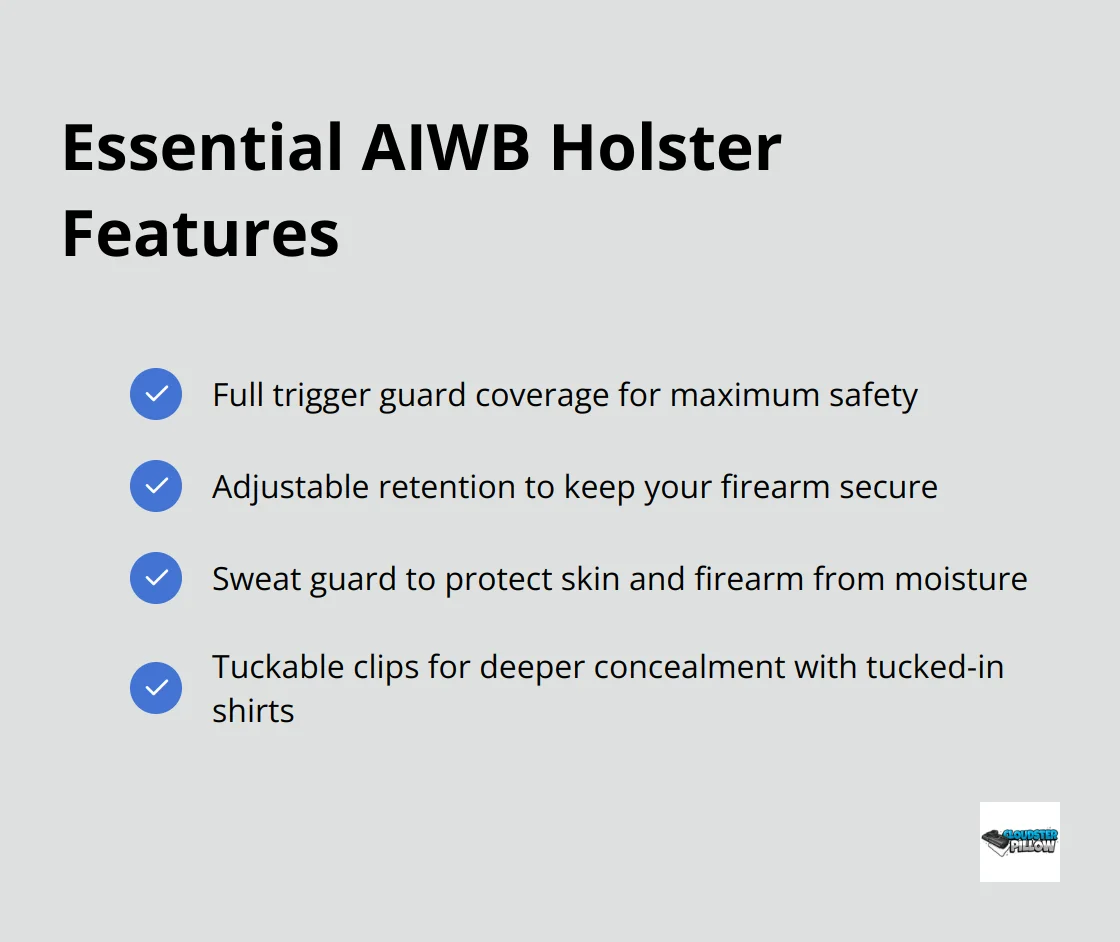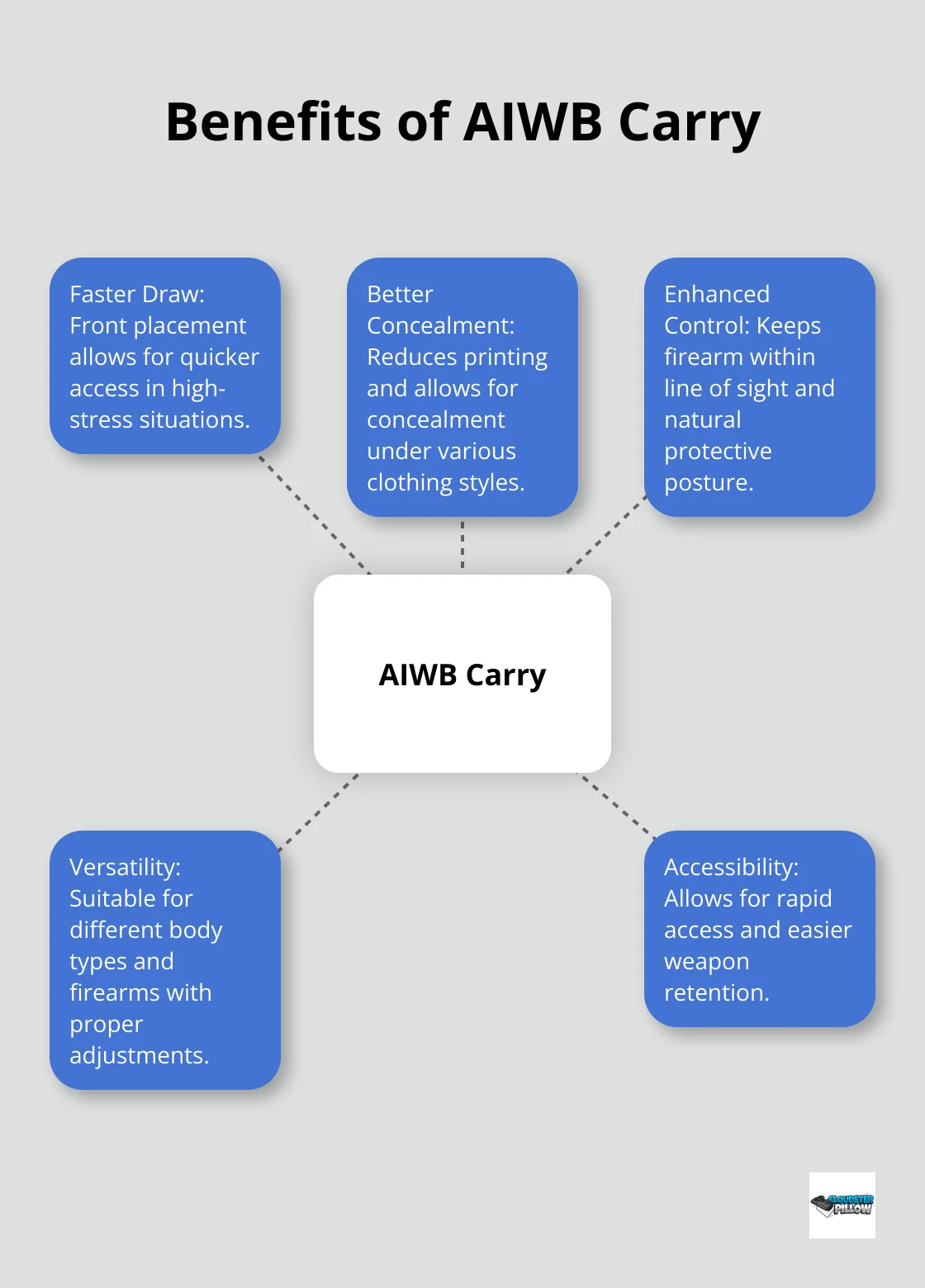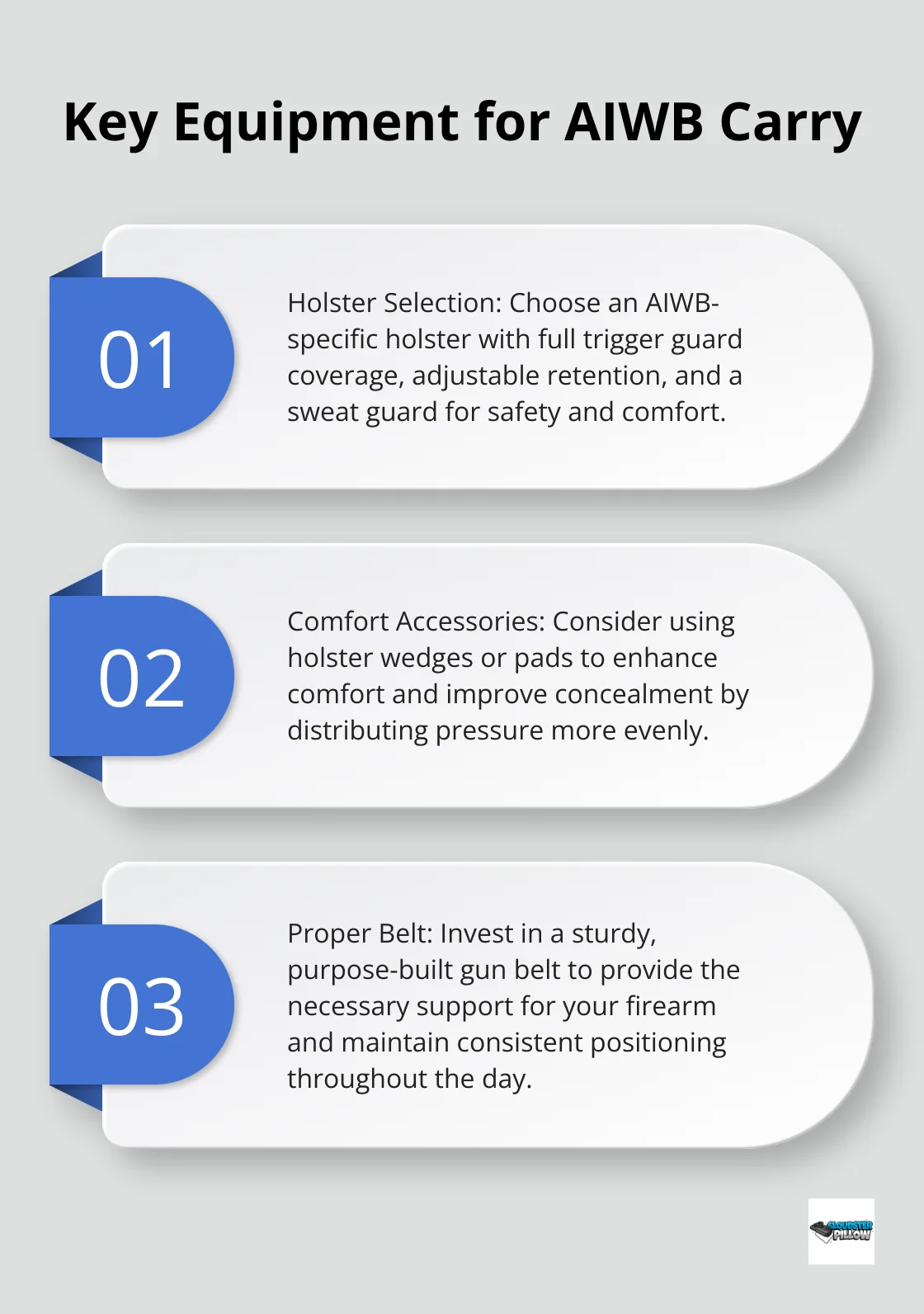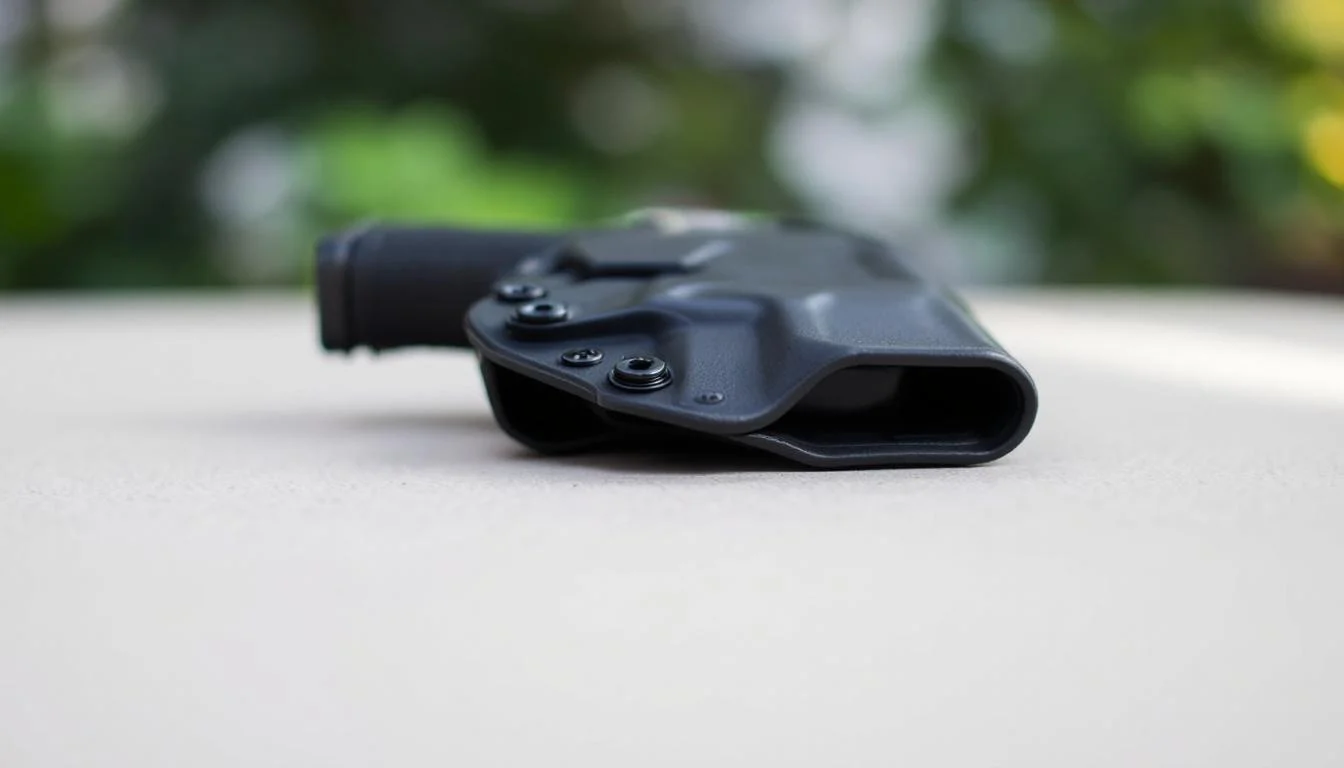AIWB, Appendix Carry
Is an AIWB Holster Right for You?
At Cloudster Pillow, we understand the importance of finding the right holster for your concealed carry needs. AIWB holsters have gained popularity among CCW enthusiasts for their unique advantages.
This guide will explore whether an AIWB holster is the right choice for you, considering factors like comfort, concealment, and safety. We’ll break down the pros and cons to help you make an informed decision about your carry method.
What Is AIWB Carry?
Understanding Appendix Inside the Waistband
Appendix carry is typically concealed inside the waistband in the 1-2 o’clock position – or right in front of your hip. This carry style has become increasingly popular among CCW enthusiasts for its unique blend of accessibility and concealment.
The AIWB Advantage
AIWB holsters offer several benefits over traditional carry positions. The front placement allows for a faster draw, as your hand naturally rests closer to the firearm. This can prove vital in high-stress situations where every second counts.
Comparing Carry Positions
Unlike strong-side hip carry (3-5 o’clock position), AIWB keeps your firearm within your peripheral vision and easier to protect. This placement also reduces printing (the visible outline of your gun through clothing). Many users report that AIWB conceals better under a wider variety of clothing styles, from t-shirts to business attire.
Essential AIWB Holster Features
When selecting an AIWB holster, look for these key features:

Growing Popularity of AIWB
The popularity of AIWB carry has been growing among concealed carriers. However, it’s important to invest in quality gear and proper training to maximize the benefits of AIWB carry.
As we explore the advantages of AIWB carry in the next section, you’ll discover why this method has become a top choice for many responsible gun owners and daily carriers.
Why AIWB Carry Shines
Lightning-Fast Draw
AIWB carry puts your firearm right where you need it. The front placement allows for a quicker draw compared to other carry positions. In high-stress situations, this can make a significant difference. A recent study comparing draw times between a retention holster and an appendix style holster revealed a statistically significant difference. In a self-defense scenario, every fraction of a second counts.
Stealth Mode Activated
One of the biggest challenges for concealed carriers is to avoid printing. AIWB excels in this area. Appendix Inside-the-Waistband (AIWB) carry places your firearm between the 12 and 2 o’clock positions. This setup is great for concealment, allowing for better concealment under a wider variety of clothing. A loose t-shirt or untucked button-down can easily hide your firearm without the need for special clothing or accessories. This versatility makes AIWB an excellent choice for those who want to carry discreetly in different settings and outfits.
Enhanced Control and Retention
AIWB carry keeps your firearm within your line of sight and natural protective posture. This positioning makes it easier to defend against attempts to grab your weapon. Additionally, many AIWB holsters are tuckable, meaning you can tuck your shirt or cover garment between the holster and the belt clip for enhanced concealment. Rapid access is also a key benefit of this carry method.
Versatility for Different Body Types and Firearms
AIWB carry isn’t just for one body type or firearm. Whether you carry a compact Glock 19 or a full-size 1911, there’s an AIWB holster that can work for you. The key is to find the right holster and make small adjustments to your carry setup. You can experiment with different cant angles, ride heights, and holster designs to find the perfect fit for your body and firearm.

Quality Gear and Training
While AIWB carry offers numerous benefits, it’s important to invest in quality gear and proper training to maximize these advantages. Many AIWB carriers use accessories (like wedges or pads) to enhance comfort and concealment. The right equipment can make a world of difference in your everyday carry experience.
As we move forward, let’s explore some important considerations and potential drawbacks of AIWB carry to help you make an informed decision about whether this carry method is right for you.
AIWB Carry Challenges
Safety Considerations
Safety remains the top priority for AIWB carry. The firearm’s proximity to vital organs and arteries raises valid concerns. To address these, users must select a high-quality holster that fully covers the trigger guard. There are cases of prohibited persons suffering a negligent discharge as holster-less AIWB is also sometimes referred to as felon carry.
A holster with adjustable retention ensures the firearm stays securely in place. Additionally, a holster with a sweat guard protects both skin and firearm from moisture.
Comfort Optimization
Comfort can present a significant hurdle for new AIWB carriers. The gun’s position may cause discomfort when sitting or bending. To mitigate this, users should experiment with different ride heights and cant angles. Many find that raising the holster slightly or angling it away from the body improves comfort dramatically.
Holster wedges (like those offered by Cloudster Pillow) are specifically designed to enhance comfort for AIWB carry. These accessories help distribute pressure more evenly and can significantly reduce discomfort, especially during extended wear.
Training Requirements
Effective AIWB carry demands dedicated training. The draw stroke differs from traditional strong-side carry, and users need to practice to build muscle memory. A smooth, safe draw and re-holster technique is essential. Many reputable training facilities now offer AIWB-specific courses.
Time invested in dry fire practice and range sessions helps users become proficient with their setup.
Legal Awareness
Legal considerations vary widely by jurisdiction. Some areas have specific regulations about firearm positioning or visibility. For example, Texas law requires that the firearm be “concealed,” which could impact the choice of cover garment with AIWB carry.
Users must research and comply with their local laws. The National Rifle Association’s Institute for Legislative Action (NRA-ILA) provides up-to-date information on state-specific carry laws.
Equipment Selection
Choosing the right equipment is critical for successful AIWB carry. Users should select a holster designed specifically for AIWB carry (not a repurposed IWB holster). Features to look for include:

Quality gear can make a significant difference in comfort, concealment, and overall carry experience.
FAQs
What is AIWB carry?
AIWB (Appendix Inside the Waistband) carry involves carrying your firearm in the 1-2 o’clock position, right in front of your hip. It offers a unique blend of accessibility and concealment, making it a popular choice for concealed carry enthusiasts. The positioning allows for a faster draw and better retention, especially in high-stress situations.
What are the advantages of AIWB carry?
AIWB carry has several advantages, including:
- Faster Draw: The front placement of the firearm allows for quicker access, which can make a significant difference in self-defense situations.
- Better Concealment: AIWB carry hides your firearm under a wide variety of clothing, from loose t-shirts to business attire, making it easier to carry discreetly.
- Enhanced Control: The position of the firearm makes it easier to protect and defend against attempts to grab it.
- Versatility: AIWB is suitable for various body types and firearms, offering flexibility in how you carry.
- Accessibility: With the firearm within your peripheral vision and reach, it becomes more accessible and easier to protect.
What are the essential features of an AIWB holster?
When selecting an AIWB holster, consider the following essential features:
- Full Trigger Guard Coverage: Ensures safety and prevents accidental discharges.
- Adjustable Retention: Allows you to customize the holster’s grip on your firearm.
- Sweat Guard: Protects your firearm from moisture and prevents skin irritation.
- Tuckable Clips: Allows you to tuck your shirt between the holster and belt for enhanced concealment.
What are the challenges of AIWB carry?
While AIWB carry has many benefits, there are also some challenges, such as:
- Safety Concerns: The firearm’s proximity to vital organs raises valid concerns, so it’s important to use a high-quality holster with full trigger guard coverage and adjustable retention.
- Comfort Issues: The AIWB position can cause discomfort when sitting or bending. Adjusting ride height, cant angles, and using holster wedges (like the Cloudster Pillow) can improve comfort.
- Training Requirements: Effective AIWB carry requires dedicated practice to build muscle memory for a safe and smooth draw stroke.
- Legal Awareness: Some states have specific regulations about firearm positioning and concealment, so it’s important to research and comply with local laws.
How can I optimize my AIWB carry experience?
To optimize your AIWB carry experience, invest in quality gear, experiment with holster adjustments, and practice regularly. Accessories like holster wedges and pads can enhance comfort, and training will help you refine your draw stroke. Additionally, make sure your holster is specifically designed for AIWB carry to ensure maximum comfort, concealment, and safety.
Final Thoughts
AIWB holsters offer a unique blend of accessibility, concealment, and versatility for concealed carry. The front placement allows for quick draws and better weapon retention, while also providing excellent concealment under various clothing styles. However, you must consider the safety aspects, comfort challenges, and legal implications that come with this carry method.
The decision to use an AIWB holster depends on your individual needs, body type, and lifestyle. What works perfectly for one person may not be ideal for another. We encourage you to explore different carry positions and holster types to find what suits you best.
Quality gear is paramount for a safe and comfortable AIWB carry experience. The Cloudster Pillow can enhance your AIWB carry comfort and concealment (its adjustable shredded cooling gel memory foam helps reduce pressure points and minimizes printing). Seek out professional instruction to develop safe handling techniques, practice your draw stroke, and build the confidence needed for responsible concealed carry.

